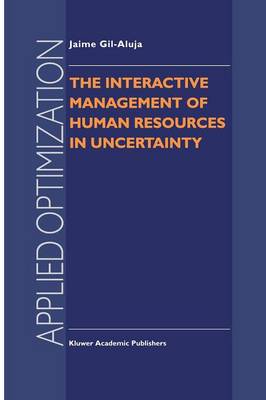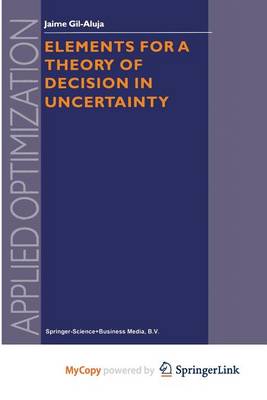Applied Optimization
3 primary works
Book 11
The Interactive Management of Human Resources in Uncertainty
by Jaime Gil-Aluja
Published 31 December 1997
101 17. The company job balance sheet 101 18. The personnel and jobs structure 119 19. Work in homogeneous groups 125 20. Incorporation of Galois lattices 130 21. The selection of teams for associated tasks 134 22. A brief reference to costs 138 23. Problems associated with personnel assignment 140 The Hungarian assignment algorithm 24. 148 Theoretical elements of the Hungarian algorithm 25. 158 Assignment by means of the "Branch and Bound" 26. 170 Changes, abilities and costs 27. 181 28. Development of the capacity of initiative 186 29. Specialization or adaptable qualification 190 30. Incorporation of uncertainty 206 Economic incidence of passing of over from specialisation 31. to adaptable qualification 214 32. Retraining through the acquisition of new abilities 218 REFERENCES 222 FINAL CONSIDERATIONS 224 VI PREFACE The ups and downs faced by society during the latter half of the XX'Th century, have left remnants, from the uncertainty of which could emerge a different way of living together. This not only includes new ways of looking at more or less old problems, it also means a profound change of the very foundations on which investigation is based.
Book 21
FIRST PART Preparation of the Investment 1. Investments in the Company 19 The decline of stability . . 19 The change in direction of studies on the investment process. 25 Basic elements for arithmetical study of selection 29 Thc study of selection from non-numerical elements. 37 2. Programming Investment Activity 49 Classical programming techniques. 49 Handling of an investment programme. 56 Incorporation of costs into investment projects . . . . . . . . . . . . . . . . . . 66 Estimating financial needs throughout the process. 72 3. Financial Risk of Investment 85 Financial aspects of the investment process. 85 Determination of the financial capacity of the investment . . 89 From pre-diagnosis to diagnosis. 102 Numerical determination of the financial risk of an investment. 106 4. Analysis of financial products for the investment 113 Aspects prior to product analysis. 113 Analysis by means of the clan concept . . . . . . . . . . . . . . . . . . . 117 Obtaining affinities and thc use of codes . . . . . . . . . . . . . . . . . . . . . . . . . . . . . . . . . . . . . . . . . . . . . 123 Grouping the characteristics of the products by means of the Moore closing. 126 From product grouping to affinities . . . . . . . . . . . . . . . . . . . . . . . . . . . . . . . . . . . . . . . . . . . . . . . . . . . . . . . . . 134 10 / Index SECOND PART Selection 5. A first approximation to selection models 145 Updating of monetary currents 145 Incorporation of the lack of precision of interests rates . . . . . . . . . . . . . . . . 153 The hypothesis of known net values and fuzzy rate of interest . . . . . . 157 6. Selection of investments in an economy with inflation 165 Estimate of monetary currents at constant prices . . . . . . . . . . . . . . . . . . . 165 Estimate of monetary currents at prices for each period . . . . . . . 172 The hypothesis of different rates of inflation . . . . 180 7.
Book 32
Decisions in uncertainty Scientific reaction to change During latter decades, the basic elements that have traditionally made up the society in wh ich economic activity develops, have been submitted to the effect of multiple aggressions as a consequence of the outcome of events motivated by the nature itself of the human being, always seeking a level of happiness that is never reached. In a very brief manner we are accustomed to mention these by using words such as revolution, profound changes, convulsions . . . . , the results of which are manifest through non-linear reactions that lead to a future charged with uncertainty. To get to know, explain and treat this new world constitutes one of the many objectives of those who desire a society in the service of man, and for those who aspire to the fact of the concept of mutuality transcending the use less limits of the printed word. But for this it will be necessary to overcome a whole realm of obstacles placed in the way by those comfortably embedded in old principles, decrepit ideas and are not willing to open the windows of their mind to receive the fresh air of a new era.


